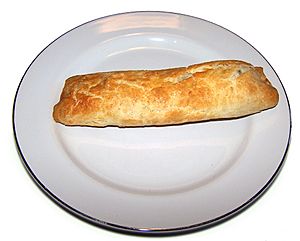Bedfordshire clanger facts for kids
 |
|
| Alternative names | Hertfordshire clanger, Trowley dumpling |
|---|---|
| Type | boiled suet dumpling (traditional); baked pastry (some modern recipes) |
| Place of origin | United Kingdom |
| Region or state | South Midlands (Bedfordshire, Buckinghamshire; also Hertfordshire, Cambridgeshire, Huntingdonshire) |
| Associated national cuisine | English cuisine |
| Serving temperature | hot, or ambient temperature |
| Main ingredients | suet pastry; liver or meat; potatoes; onions; jam or fruit |
| Ingredients generally used | sage |
| Similar dishes | Bacon Badger (Buckinghamshire); Bacon Pudding (Sussex) |
The Bedfordshire clanger is a special kind of food from Bedfordshire and nearby areas in England. It's also known as the Hertfordshire clanger or Trowley Dumpling. This tasty dish has been around since at least the 1800s. You can still find it today in some bakeries, cafes, and restaurants.
The word "clanger" might come from an old word "clung." This word meant "heavy" when talking about food. This makes sense because the clanger is a very filling meal!
What is a Bedfordshire Clanger?
The clanger is a long, oval-shaped pastry made with suet dough. Some people compare it to a savoury version of a roly-poly pudding. Its name probably comes from its dense and heavy texture. Old dictionaries from the 1800s describe "clung dumplings" from Bedfordshire. They also use words like "clungy" and "clangy" to mean heavy or thick.
Historically, women would make clangers for their husbands. The men would take them to their farm jobs as a midday meal. Some people think the thick crust was not meant to be eaten. It might have been there to protect the fillings from dirty hands. Workers could eat them cold. They could also warm them up by wrapping them in damp newspaper under a brazier (a type of heater). While often linked to hat makers in Luton, this dish was also common in rural Buckinghamshire, Cambridgeshire, and Hertfordshire.
How is a Clanger Made?
Traditionally, clangers were boiled in a cloth. This is similar to how other suet puddings are cooked. However, some modern recipes use a different type of pastry, like shortcrust. These versions are often baked, much like a pasty. This baking method became popular in the 1990s when a bakery started making clangers again.
The dumpling can have many different fillings. Common savoury fillings include liver and onion, bacon and potatoes, or pork and other vegetables. The herb sage is often added for flavour.
Clangers are usually savoury. But some were also made with a sweet filling, like jam or fruit, at one end. This version was sometimes called an "'alf an' 'alf" (half and half). The name "clanger" was then used only for the savoury version. A reference from 1959 suggests that the sweet-and-savoury clanger was called the Trowley Dumpling. This was named after a small village in west Hertfordshire. Today, many recipes include a sweet filling at one end to keep this tradition alive.
Similar Dishes
A similar dumpling is known in parts of Buckinghamshire. Especially in Aylesbury Vale, it was called a "Bacon Badger." This dish was made with bacon, potatoes, and onions. It was flavoured with sage and wrapped in a suet pastry case. It was usually boiled in a cloth, just like the clanger.
The meaning of "badger" in this name is not fully known. It might relate to an old term for someone who sold flour. In the early 1800s, "badger" was used in the Midland counties. It referred to a "cornfactor, mealman, or huckster" (someone who dealt with grain or food).
The same basic suet dumpling recipe has other names across the country. In County Durham, it's called "flitting pudding." From Derbyshire, it's known as "dog in blanket." In Berkshire and Sussex, it's called "bacon pudding."

